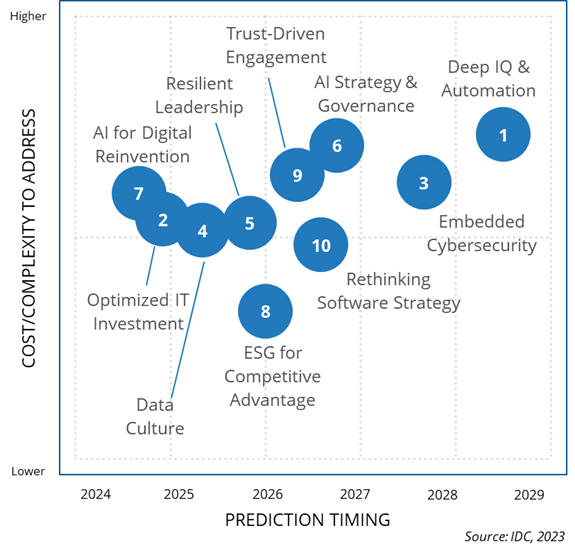The role of the Chief Information Officer (CIO) has evolved significantly in the digital age. From managing IT infrastructure to becoming key business strategists, CIOs now stand at the intersection of technology and business, leveraging innovations to shape organizational directions, create value, and boost revenue.
The “IDC FutureScape: Worldwide CIO Agenda 2024 Predictions” provides valuable insights into the future of this role. The FutureScape prediction looked at ten different predictions across the next four years and their impact for CIOs (see Figure, below). In this blog we will detail out the first five.

Here are five key predictions that every CIO should be aware of:
1. Embracing AI, Automation, and Analytics
By 2028, it is predicted that 85% of CIOs will leverage organizational changes to harness AI, automation, and analytics, driving agile, insight-driven digital businesses. This means that CIOs will need to stay ahead of the curve in understanding these technologies and implementing them effectively within their organizations. The most challenging aspect will not be the technology, but aligning both the business and technical cultures to make these changes successful.
2. Pressure to Adopt Digital Tech
By 2024, 65% of CIOs will face pressure to adopt digital tech such as GenAI and deep intelligence. However, limited IT support may diminish the benefits and heighten risks. CIOs will need to ensure they have the right support and talent in place to navigate these challenges and reap the benefits of these advanced technologies. In fact, we give in-depth guidance on approaches to adopting and applying GenAI to the organization in this eBook. In some cases, IT may have the talent they can leverage internally or train-up, but in other cases, IDC sees CIOs leveraging third-parties to initially provide this talent and support.
3. Proactive Cybersecurity Measures
By 2027, 75% of CIOs will integrate cybersecurity measures directly into systems and processes to proactively detect and neutralize vulnerabilities, fortifying against cyberthreats and breaches. This highlights the increasing importance a multi-layer, systematic and systemic approach to cybersecurity protection rather than the more traditional point solution approach organizations have adopted over the years. Download this checklist to unlock that set of practices that Technology Leaders should employ to proactively protect your organization.
4. Prioritizing Strategic Data Management
By 2025, 45% of CIOs will prioritize strategic data management and foster a data-centric culture, ensuring competitive differentiation in the digital era. This means that CIOs will need to focus on how data is managed and used within their organizations, ensuring it is used strategically to drive business outcomes. As part of this, IT organizations will need to work with the business to identify what data is critical to achieving business outcomes and also the quality of the data. And as part of driving out a data centric culture, creating a common data platform (which doesn’t mean one tool, but common set of process, practices, and accessibility of data) is critical to enterprise success.
5. Misaligned Investments Hindering Business Performance
Two-thirds of CIOs will not meet their 2025 digital revenue goals due to misaligned investments hindering business performance. This highlights the need for CIOs to ensure their IT investments align with their business goals and strategies and that CIOs must understand both their company and the markets their company competes in. CIOs can no longer simply be good technologists. They also must gain acumen in their business and their market. They must understand the ‘art of the possible’ with technology and be able to translate it in terms that brings business conviction.
Above all, these forecasts highlight the crucial need for CIOs to sync up IT investments with the wider business strategy. It’s not enough to chase the latest trends; it’s about ensuring that every tech move aligns with the company’s goals. By fostering collaboration between tech experts and business leaders, CIOs can steer their organizations toward sustainable growth and success in the digital age. So, as we look ahead, let’s embrace these insights, stay agile, and keep innovating to thrive in tomorrow’s world.
To wrap things up, the IDC FutureScape forecasts paint a vivid picture of the road ahead for CIOs navigating the ever-evolving tech landscape. From AI to automation and analytics, the opportunities for innovation are huge. Yet, it’s not just about adopting shiny new tools; it’s about building a solid foundation of data management, resilient platforms, and proactive cybersecurity measures.
For more IDC FutureScape content for CIOs, be sure to check out the on-demand webinar, IDC FutureScape: Worldwide CIO Agenda 2024 Predictions. Click the button below to watch the webinar now.




